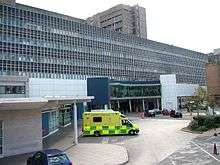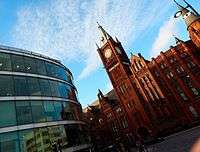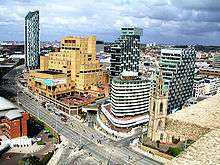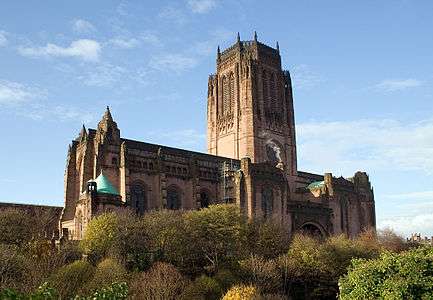Royal Liverpool University Hospital
| Royal Liverpool University Hospital | |
|---|---|
| Royal Liverpool and Broadgreen University Hospitals NHS Trust | |
 Main Entrance and Emergency Department at the existing Royal Liverpool University Hospital (completed in 1978) | |
 Location in Liverpool  Location in Merseyside | |
| Geography | |
| Location | Prescot Street, Liverpool, L7 8XP. |
| Coordinates | 53°24′34″N 2°57′51″W / 53.40944°N 2.96412°WCoordinates: 53°24′34″N 2°57′51″W / 53.40944°N 2.96412°W |
| Organisation | |
| Care system | Public NHS |
| Hospital type | Teaching |
| Affiliated university | University of Liverpool, Liverpool John Moores University, Liverpool School of Tropical Medicine |
| Services | |
| Emergency department | Yes Accident & Emergency; Major Trauma Centre |
| Beds | 850 |
| Speciality | Organ Transplantation, Nephrology, Endocrinology, Ophthalmology, Vascular Surgery, Hepatology, Hepatobiliary Surgery, Orthopaedics, Oncology, Respiratory Medicine, Regional Tropical and Infectious Disease Unit. |
| History | |
| Founded | 1978 |
| Links | |
| Website | http://www.rlbuht.nhs.uk |
The Royal Liverpool University Hospital (RLUH) is a major teaching and research hospital located in the city of Liverpool, England. Alongside Broadgreen Hospital and Liverpool University Dental Hospital; the hospital belongs to and operates on behalf of the Royal Liverpool and Broadgreen University Hospitals NHS Trust and is associated with the University of Liverpool, Liverpool John Moores University and the Liverpool School of Tropical Medicine.
The Royal Liverpool is the largest and busiest hospital in Merseyside and Cheshire, and has the largest emergency department of its kind in the UK.[1]
History
Current hospital
The current hospital was designed to replace three other city centre acute hospitals that existed at the time – the Liverpool Royal Infirmary on Pembroke Place, the David Lewis Northern Hospital on Great Howard Street, and the Royal Southern Hospital on Caryl Street.[2] It had been agreed to amalgamate the separate facilities on a site within close proximity to the University of Liverpool for the purposes of medical education and research. The site on which the current hospital now stands (on Prescot Street) was identified as part of the post-war regeneration of Liverpool. However, building on the main hospital did not commence until 1963. The first phase of the hospital was designed by Holford Associates and built by Alfred McAlpine between 1963 and 1969.[3] The construction was plagued from the outset by problems of cost, time and quality, together with difficulties over fire certification due to changes in health and safety law whilst building work was ongoing. The second phase was completed and the hospital eventually opened in 1978.[4]

Redevelopment
In December 2013 the landmark £429 million redevelopment of the Royal Liverpool University Hospital, procured under a Private Finance Initiative contract, reached financial close; its collaborative links with the University of Liverpool, and institutes on the Liverpool BioCampus, have given the city of Liverpool recognition as one of the leading UK centres for health research and innovation.[5] The new Royal Liverpool University Hospital, which was designed by NBBJ and HKS[6] and was being built by Carillion, was expected to be the largest all single-patient room hospital in the UK upon its originally scheduled completion of March 2017.[7][8]
In March 2017, the project was running more than a year late due to problems caused by asbestos, cracking concrete and bad weather,[9] and further delays were announced in early January 2018.[10] Less than a fortnight later, on 15 January 2018, Carillion went into liquidation, partly due to its problems with the hospital contract, and delaying the project still further,[11][12] with the hospital unlikely to be finished in 2018.[13] On 26 March 2018, it was reported that the project had been costing £53.9m more than Carillion had officially reported.[14] In September, the NHS Trust revealed that the cost of rectifying serious faults, including replacing non-compliant cladding installed by Carillion, was holding up plans to restart and finish the £350m project; with the project further delayed, the Trust was considering invoking a break clause to terminate the PFI contract.[15] On 24 September 2018, it was reported that the government would step in to terminate the PFI deal, taking the hospital into full public ownership, meaning a £180m loss for private sector lenders Legal & General and the European Investment Bank.[16] This was confirmed on 26 September 2018, with completion of the hospital in 2020 likely to cost an additional £120m, due to unforeseen issues left behind by Carillion.[17] Construction work was expected to resume in November 2018.[18]
Rating
In 2007, the Healthcare Commission rated Royal Liverpool and Broadgreen University Hospitals NHS Trust "Good" for 'Quality of Services' and Good for 'Use of Resources'.[19] In 2009, Royal Liverpool and Broadgreen University Hospitals NHS Trust was rated "Excellent" for the quality of its services and the quality of its financial management.[20]
Teaching and research
The Royal Liverpool University Hospital is a major teaching and research hospital for student doctors, nurses, dentists and allied health professionals. The hospital works with the University of Liverpool, Liverpool John Moores University and the Liverpool School of Tropical Medicine.[21]
See also
References
- ↑ "Royal Liverpool Hospitals". Rlbuht.nhs.uk. 23 May 2010. Retrieved 19 September 2016.
- ↑ "Hospital Records". E. Chambré Hardman Archive. Retrieved 5 October 2018.
- ↑ Gray, p. 107
- ↑ "Royal Liverpool Hospital". Hansard. 13 February 1980. Retrieved 29 September 2018.
- ↑ Your Name Here. "About Us – Liverpool Health Campus". Liverpoolbiocampus.com. Retrieved 19 September 2016.
- ↑ "NBBJ and HKS bag Royal Liverpool Hospital job". Architect's Journal. 2 May 2013. Retrieved 19 September 2016.
- ↑ "New £429m Royal Liverpool University Hospital given the green light – BBC News". BBC. Retrieved 19 September 2016.
- ↑ "Royal Liverpool Hospital: New design unveiled – BBC News". BBC. Retrieved 19 September 2016.
- ↑ Belger, Tom (31 March 2017). "Construction of new Royal hospital delayed again by a YEAR". Liverpool Echo. Retrieved 2 February 2018.
- ↑ Sembhy, Ravender; Houghton, Alistair (3 January 2018). "Here's why Royal Liverpool Hospital builder Carillion is in trouble - and why it matters". Liverpool Echo. Retrieved 2 February 2018.
- ↑ Matthews-King, Alex (16 January 2018). "Alarm in hospitals as NHS triggers emergency plans in 14 trusts after Carillion collapse". Independent. Retrieved 21 January 2018.
- ↑ Davies, Rob; Clark, Tim; Campbell, Denis (19 January 2018). "Carillion collapse further delays building at two major hospitals". Guardian. Retrieved 21 January 2018.
- ↑ "Carillion collapse delays new £335m Liverpool hospital". BBC News. BBC. 6 February 2018. Retrieved 6 February 2018.
- ↑ Price, David (26 March 2018). "Carillion understated hospital costs by £70m". Construction News. Retrieved 26 March 2018.
- ↑ Morby, Aaron (12 September 2018). "Stalled Royal Liverpool Hospital fails cladding check". Construction Enquirer. Retrieved 13 September 2018.
- ↑ Kleinman, Mark (24 September 2018). "Ministers bail out £335m Liverpool hospital after Carillion collapse". Sky News. Retrieved 24 September 2018.
- ↑ Brown, Faye (26 September 2018). "Royal Liverpool Hospital "to open in 2020" after PFI deal with Carillion ripped up". Liverpool Echo. Retrieved 26 September 2018.
- ↑ Prior, Grant (27 September 2018). "Construction to restart this year on Royal Liverpool Hospital". Construction Enquirer. Retrieved 27 September 2018.
- ↑ 2007 Rating
- ↑ 2009 Rating
- ↑ "Liverpool Health Campus". Liverpool School of Tropical Medicine. Retrieved 28 October 2017.
Sources
- Gray, Tony (1987). The Road to Success: Alfred McAlpine 1935 - 1985. Rainbird Publishing.
| Wikimedia Commons has media related to Royal Liverpool University Hospital. |



